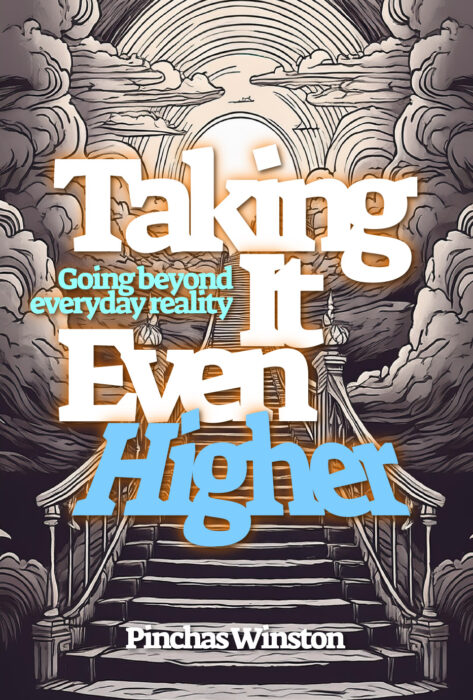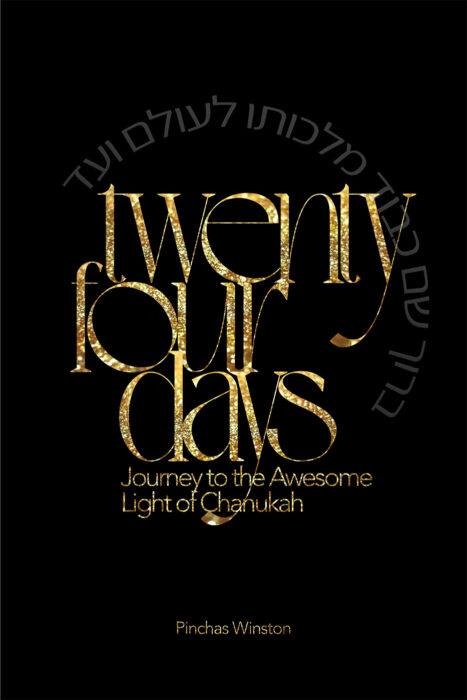Parashas Shoftim, Issue #2010 – By Rabbi Pinchas Winston
Friday Night
There are basically two types of mitzvos, mishpatim and chukim, or judgments and statutes. In English there is not much difference between the two, but in Torah law there is. A mishpat, like “do not steal,” is a law whose relevance to life we can see. A chok, like not cooking meat and milk together, is a Torah law whose rational seems beyond us—for now. We just don’t see how not doing so makes the world a better place, especially since non-Jews cook milk and meat together all the time, seemingly without consequence.
That is the difference between mishpat and chok in terms of definitions. What does it mean in terms of reality?
An example might be a family of five children, the youngest child being eight years old, and each subsequent child being two years older than the one after them. The difference in comprehension between the youngest child and second youngest will not be as great as the difference between the eight-year old and the 12-year old, etc. If the oldest child, the 16-year old, happens to discuss something they learned with the eight-year old, the younger one will probably not understand a thing.
The same thing is true of reality. It looks to us as if there is only one, but we know that it too has levels, five general ones, according to Kabbalah. Their Hebrew names are, from the bottom up, Asiyah, Yetzirah, Beriyah, Atzilus, and Adam Kadmon. As the Arizal explains, each name has a specific meaning, but that is parenthetical for the time being.
We live on the level of Asiyah, which evidently is capable of a tremendous lack of spirituality. People can even doubt the existence of God and seemingly get away with it, for now.
At the other end is Adam Kadmon, so sublimely spiritual that we can’t fathom what it is like. Instead, we kind of reverse engineer it, learning about it from what came out of it, Atzilus. It is like learning about a parent we don’t know from their children whom we do know.
In-between these two worlds are Yetzirah, Beriyah, and Atzilus, which act as transitions from one level to the next. Beyond the highest level is Ohr Ain Sof, God’s infinite light, which is even more unfathomable. Beyond that is something called Atzmus, or Essence, but that is so beyond comprehension that we’re not even supposed to wonder about it.
Shabbos Day
Back to the five levels we can think and talk about.
As a person ascends from Asiyah to Yetzirah they enter a holier realm and a higher level of consciousness. We could call it a higher level of spiritual consciousness, but the truth is, it doesn’t matter. All consciousness is spiritual, even for people who don’t believe in spirituality. It’s just that for those on a lower level of consciousness, it doesn’t seem very spiritual.
How does a person ascend from one level of consciousness to a higher one? Through ideas. In other words, when a person learns and then tries to relate to a loftier idea, it pulls their consciousness up to the level of the concept. If you want to transcend the level of consciousness of Asiyah, you have to learn ideas from the level of Yetzirah.
Kabbalah refers to this process of intellectual elevation as Pardes. Though pardes actually means orchard, here it is a roshei teivos. The four letters, Peh, Raish, Dalet, and Samech, are also the first letters of four different words: Pshat, Remez, Drush, and Sod—Simple, Hint, Elucidation, and Secret, four different levels on which a Torah idea can be learned.
For example, the first word of the Torah is Bereishis, which is usually translated as “in the beginning.” That is the simplest and most obvious explanation of the word, the level called Pshat.
But as Rashi points out, the word is not in the proper construct to say that. It should have written berishonah to say “in the beginning,” not bereishis. But this was not a mistake, but a hint—remez—to a deeper level of meaning, which Rashi explains.
But even Rashi’s insight is not the final level of explanation. According to Drush, the word bereishis elucidated is really two words, bara and shis, which means “He created six.” Six what? The six days of Creation and the six millennia of history that have followed, at least in potential, the moment God said “Bereishis.”
But even that is not the final level of understanding of the first word of the Torah. There is still the level of Sod, or Kabbalah, at least, as far as what God has revealed to us. Sod also reads the word as bara shis, except in this case, the shis refers to the six sefiros of Chesed, Gevurah, Tifferes, Netzach, Hod, and Yesod, which have been, and still are, the basis of the six days of Creation and the six thousand years that have followed.
This information alone about the word Bereishis is enough to change a person’s level of consciousness, if they take the time to meditate on it and appreciate its implications. Even the deepest ideas won’t change a person if they go in one ear and come out the other.
But as a person continues to learn Torah on increasing deeper levels, they will find themselves quite automatically switching spiritual gears. Secular knowledge, which is the level of the Aitz HaDa’as Tov v’Ra, the Tree of Knowledge of Good and Evil, can become increasingly more sophisticated intellectually, but rarely spiritually. This is why it generally does not change people spiritually for the better.
But Torah is the level of the Aitz HaChaim, the Tree of Life, and has the built-in capacity to become increasingly more sophisticated intellectually and more importantly, spiritually. It deals with the revelation of God in Creation and His interaction with it. The more revealed this knowledge becomes to a person, the more spiritual they automatically become.
Seudas Shlishis
However, it’s not like in a building in which you can see yourself go from level to level. On the contrary, the physical world doesn’t change any more for a spiritual person than it does a non-spiritual one. What changes is the personal connection the spiritual person develops to the world around them, changing their experience of it and the level of pleasure they can get from it.
In essence, that’s what Gan Aiden was, is, and what it means to have been exiled from it. Being post-Garden and relating to the world so physically, we imagine Paradise being just a better physical version of the world we know. We think it is just physically hidden somewhere we cannot find on a map.
But what made Gan Aiden a better physical place was that it was a better spiritual place. It was Gan Aiden on the level of consciousness on which man was created, and ceased to be Gan Aiden once man sinned and greatly lowered his level. Being exiled from the Garden was being exiled from the level of consciousness on which it could be perceived, experienced, and enjoyed.
That’s why the word pardes and paradise are so similar. The original Paradise was a pardes, an intellectual one. In fact, when God told Adam HaRishon to “protect and work” the garden, it referred to the learning of Pardes, not the actual physical gardening we now do. Maintaining a Gan Aiden consciousness maintained Gan Aiden itself.
This is why, if you learn Kabbalah, you will see levels of sefiros referred to as levels of Gan Aiden. Sefiros are completely spiritual entities, and the higher up a sefirah is the less filtered and more intense God’s light is. So, by going from level to level in Pardes, one intellectually and spiritually goes from one level of consciousness to a higher level of consciousness, as this account explains:
The rabbis taught: Four entered Pardes: Ben Azzai, Ben Zoma, Acher, and Rebi Akiva…(Chagigah 14b)
That is, by way of a [Divine] Name. They didn’t actually go “up” [physically], rather it appeared to them as if they ascended. (Tosfos, q.v. Nichnas l’Pardes)
The main point here is that Gan Aiden does not exist on a different physical plane. It exists on a different spiritual plane, accessible only through higher levels of consciousness. Pardes is the intellectual ladder we need to ascend from level to level, though at this stage of history doing so may be more theoretical than actual, but that is for a later discussion.
That is the first point. The second point is that ideas look different from level to level.
It’s like getting to know a person. As you spend more time with them, you constantly discover things about them you never knew. As you do, your view of them changes because their true self is the sum total of all they know and think. The more of them you get to know, the closer you get to their true essence.
Ideas are the same. Every concept is knowledge, but knowledge has levels of comprehensibility. We learn about the same things from year to year, but what we learn about them changes over time. What seemed so simple at age eight all of a sudden seems so much more sophisticated, and sometimes so different, at age 18, etc. That can be enough to dramatically change a person’s direction in life altogether.
The knowledge of the Aitz HaDa’as, for all of its sophistication, is still very much “down here,” on the level of the tenth and final sefirah of Malchus. Science has become so phenomenally advanced and abstract, but it is still always only dealing with the very physical and relatively limited universe we see or sense.
The knowledge of the Aitz HaChaim goes far beyond the physical realm, dealing with, as much as it can, with the infinite. The deeper one penetrates the levels of Torah through Pardes, the higher the level of sefirah one accesses. And even though at this stage of history there is a limit to the level of sefirah we can reach, we can still talk about those higher levels to some degree, affecting the profundity of a person’s knowledge base.
Melave Malkah
Back to the point. Just as both the Aitz HaDa’as and Aitz HaChaim originate from the same source (everything does), so do mishpatim and chukim. The difference is that the light of certain mitzvos, the chukim, descends only so many sefiros and therefore is less filtered than the light of the mitzvos that descends all the way to the Malchus. That is the level of the mishpatim.
In other words, what makes mishpatim so relatable is not their level of logic. It is their level of filtering. Chukim are just as logical as mishpatim, but being less filtered they seem more abstract to us. We are aware of them down here vis-à-vis the Torah’s reference to them, but to truly “see” them, we have to look up at them on an intellectual and spiritual level higher than we can currently reach. Shlomo HaMelech indicated this when he wrote:
I said, “I will become wise,” but it was distant from me. (Koheles 7:23)
This is what God told Moshe Rabbeinu as well, when he questioned God’s decision to give Torah through him and not the future great Rebi Akiva. God told him:
“Silence! This is what went up in [My] mind before Me!” (Menachos 29b)
On the surface of it, it sounds as if God became impatience with Moshe’s question and told him to mind His own business. God told him that He had already made up His mind to give the Torah through Moshe, and there was nothing more to discuss.
But Kabbalah says otherwise because Kabbalah can. Not only is Kabbalah a tradition of the deeper, inside story, it finds clues to it in words or ideas that other levels of Pardes take for granted. Kabbalah may be the most mystical level of Torah learning, but it is also the most literal.
For example, the word for “mind” in God’s answer is machshavah which, Sod explains, is an allusion to the sefiros level of Machshavah Elyonah—Upper Mind. It is also called Mocha Stima’a, the closed off “brain” of Arich Anpin, the level of Keser in the sefiros. As its name implies, it is a level of light so sublime that it is literally closed off to the minds of men.
Therefore, according to this level of “pshat,” not only did God not deflect Moshe’s question, He answered it. He told him that the answer he was looking for was so high up, so sublime a level of light in the sefiros that it could not be confined to something as conventional as human words. Hence, God’s response of “Silence!” That is, it is a chok.
What we’re left with after all this is that, since there are many levels of consciousness, there are also many levels of truth. The higher the level of consciousness, the higher and truer the level of truth because it approaches the ultimate level of truth, the Ultimate Truth, God Himself. It is a whole different kind of “stroll” through a whole different kind of Pardes.
So when the Gemora makes the dire prediction of truth being missing just before Moshiach comes, we need to know what that means in terms of this discussion. The question is, is it possible to transcend the current world reality and access truth even when the world can’t? Or does the world become so cut off from truth that even those who cherish it, tragically, lose access to it as well?
(If you want the footnotes that go with this article, write me.)
Rabbi Pinchas Winston
Thirtysix.org



















